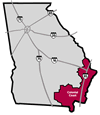
Wildlife Viewing Guide


|
Wildlife Viewing Guide |
 |
 Cumberland
Island National Seashore
Cumberland
Island National Seashore
Description: Cumberland is an Atlantic coastal barrier island that protects the mainland from the raging ocean storms. This 16-mile-long island contains several typical maritime habitats. The tidal Spartina grass marshes along the inland edge of the island function as nurseries for much of the marine life of the near shore Atlantic Ocean. The interior is live oak or pine canopy with dense palmetto understory opened by trails which are clearly marked and maintained. The dunes are composed of young shifting sands or old forested sands. Interdune meadows separate these two habitat types, the shifting dunes giving way to a spectacularly beautiful beach. Freshwater and brackish water sloughs form between the ancient dunes and provide excellent habitat for American alligators and wading birds.
Viewing Information: One of Georgia's best wildlife viewing areas, Cumberland Island demonstrates tremendous wildlife diversity, especially birds. Tidal marshes are likely to display snowy, cattle and common egrets; wood storks; and great blue, tri-color, green, and little blue herons. Black-crowned night herons and yellow-crowned night herons are rare sights in winter. In winter, large numbers of sparrows, warblers, and hawks will be seen. Peregrine falcons hunting low along the beach are a reasonable winter expectation. Bald eagles are occasionally seen soaring high (possibly with vultures) or sitting in trees or power poles along the marshes. Mammals include white-tailed deer, raccoons, river otters, minks, pocket gophers, and the recently reintroduced bobcat. The most commonly seen marine mammal is the bottle-nosed dolphin, but others may be seen off the beach and in the waterways en route to the island. In mid-summer, prominent beach tracks indicate the previous night's nesting activities of the loggerhead sea turtle. A number of non-poisonous snakes may be seen, but a more dramatic find would be the diamondback rattlesnake on the roads and in the dunes, or the cottonmouth near the freshwater sloughs. The American alligator is common in freshwater but may also be seen in saltwater. Cumberland has a long history of exotic and domestic animal introductions, as evidenced by the remaining feral horses and feral pigs. Although most of the pigs have been removed, a few may still be seen. Feral horses are more abundant, especially in the dunes and dune meadows where they do considerable damage to the vegetative stability.
Directions: From Brunswick travel I-95 south to exit 2. Travel east on GA Hwy. 40 to St. Mary's. Follow the signs to the waterfront office of the National Park Service. Ferry service to the island leaves from this location.
Management: National Park Service, St. Mary's Office, 912-882-4335
Closest Town: St. Mary's, GA
Site Notes: interpretive programs, observation platforms, rooming house (private)
Additional Information: Call the National Park Service at the number above to make reservations to visit the island. Lodging is available at the Greyfield Inn, a commercial rooming house on the island: 4 North 2nd St., Fernandina Beach, FL 32034. Rain gear and a hat for sun protection are recommended. Sand gnats are ferocious creatures and can ruin a day in the field. Insect repellents are highly recommended. A personal water supply should also be considered essential. The National Park Service owns most of the island. There are private estates remaining, however, and care should be taken to know where you are at all times. Trespassing on private property is strictly prohibited.
![]()
![]()
![]()
![]()
Read and add comments about this page